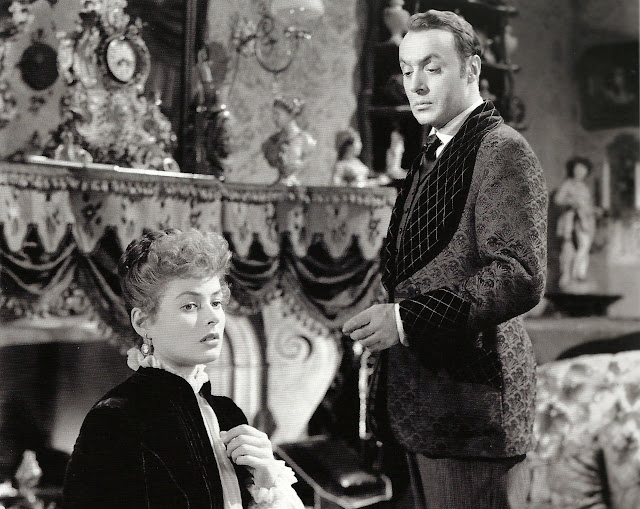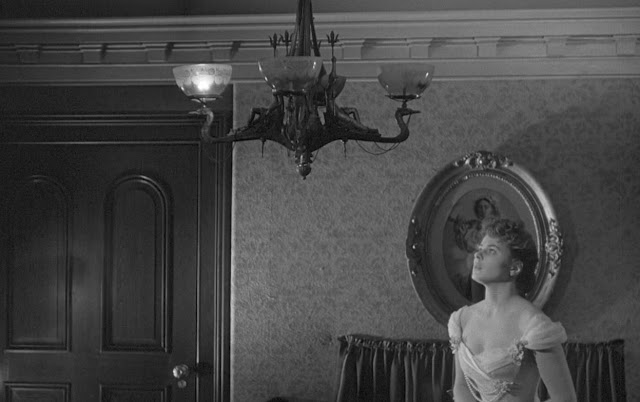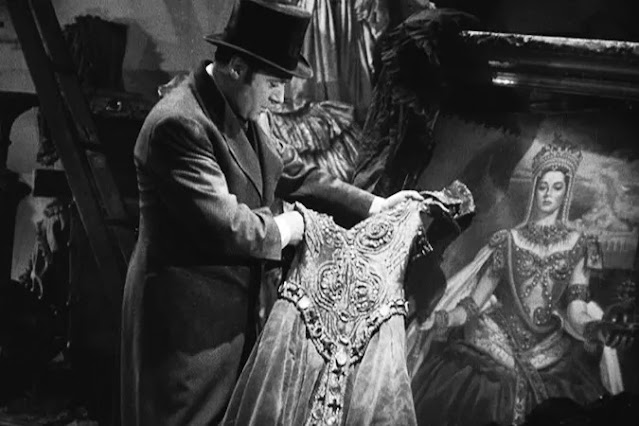Gaslight is one of those films that I had heard about for many years and have wanted to watch but never got around to it. As a fan of Ingrid Bergman’s acting it was the film most recommended to me as a showcase of what she was capable of. A few months ago a small arthouse theater was showing it but I got notice too late to rearrange my schedule enough to get to the lone showing. I would have loved to see it in a theater environment with fans of the film and experience it for the first time that way, as audiences in 1944 did. Alas, it was not to be. Finally, as part of this blog, the randomizer that picks these titles for me came up with it and I could finally watch Gaslight. I had managed for so long to avoid any story details and only knew that I was in for a treat watching Ingrid work. Two hours later, as I gather my thoughts to write this post, I’m of a mixed mind about it. I’ll explain that in just a little bit.
The story opens with a murder. World famous opera singer Alice Alquist has been killed in her London home and her niece Paula (Ingrid Bergman) has been sent to Italy to study opera and follow in her footsteps. The murderer is never found, nor a motive. Some items were obviously rummaged through but nothing else. Some years pass and Paula, now grown, marries her accompanist, Gregory Anton (Charles Boyer), after a brief romance. They agree to move back to London and take up residence in her late aunt’s long-vacant townhouse.
Paula struggles with the memories of her aunt’s murder and Gregory suggests that it would be best to relocate all of her aunt’s things into the attic and board it up so that no one may enter. He hires a young maid, Nancy (Angela Lansbury), to look after things with strict instructions to never bother his “high strung” wife. Meanwhile things begin to disappear while in Paula’s possession. A broach Gregory gives her vanishes from her purse. A picture hanging on the wall is repeatedly removed. Even Gregory’s pocket watch mysteriously disappears from his chain and is found in Paula’s purse. Gregory convinces her that it is she that is doing these things and that mental illness runs in her family. She begins to notice that the gas-powered lights dim whenever he is out of the house but the only way that can happen is if they are turned on elsewhere in the house and she cannot find where. The only place she cannot check is the attic because it has been boarded shut and no one can get in there without ripping out the boards. Gregory insists that she is imagining it all.
Meanwhile, a young man named Brian Cameron (Joseph Cotton) has seen Paula and Gregory and recognizes her from her resemblance to her aunt. Brian is an inspector working for Scotland Yard and knew Alice Alquist when he was just a child. He does some digging in the old police reports and finds out from his commander that there was something not mentioned in those reports. Alice had some expensive jewels that were not found after her death. This gets Brian wondering if the killer may be back looking for those jewels again. The film never really explains how the police know they weren’t taken by the killer in the first place, only that they were not found by the police afterwards. As time goes on, Brian grows more suspicious, especially when Paula never seems to leave the house, explained away by Gregory and the servents as her being ill and unable to go out for any reason.
The story for Gaslight came from the 1938 play by Patrick Hamilton. The idea of a husband slowly manipulating his wife into believing she is going insane was an intriguing one and has been used in several films since including the 1958 B-Movie The Screaming Skull, a film whose concept mirrors Gaslight albeit from a horror movie angle. Two years later Gaslightwas made into a British feature film starring Anton Walbrook and Diana Wynyard. When it was remade just four years after that most of the plot remained the same only on a smaller scale. Still, this original version remains popular to date and serves as an alternate take on a cinematic classic.
What the 1940’s version doesn’t have is Ingrid Bergman. Diana Wynyard was a stellar actress in her own right, even starring in her own Best Picture winning film, Cavalcade, and she is quite effective playing the role of the tormented wife. But Ingrid Bergman takes that role to a new level and what she does cannot adequately be described. I have seen her in several other films over the years and I am almost always thinking Ilsa Lund when I see her. That is not the case here. She is so transformative that I forget for a while that I’m watching an actress playing a part. When Brian is finally able to get inside the house and speak to her while Gregory is away she is so rattled and afraid thanks to her husband’s influence that her very voice trembles with the fear and uncertainty. Whenever Gregory is tricking her into believing she is unconsciously stealing and hiding things you can clearly see the confusion and fear in her eyes. This goes beyond mere acting. Ingrid has a way of inhabiting a character, especially when the role is as juicy as this one is. As good as she is playing frightened, though, my favorite part of her performance comes at the end when Gregory tries one last time to convince her everything is in her mind and she lets him think for a moment that it is working.
Less convincing is Charles Boyer, who, despite being Oscar nominated for this role, isn’t anywhere near on the same level as his co-star. His machinations are overly telegraphed and obvious. Part of this is the script’s fault. When the two are out in London early on and looking at a museum display of the royal jewels he is practically salivating over them, projecting just where his interests truly are. That could just be the direction he was given but playing it so obviously seems counter-intuitive and gives away the plot too quickly. Director George Cukor was hardly a novice in 1944 and is unlikely to have done this by accident. Unfortunately, by showing its hand this early, it loses a great deal of the suspense and mystery too early on.
Having grown up in the 1980’s I wasn’t raised on the early roles of Angela Lansbury. For me, I’m used to her later career that was heavily molded by The Walt Disney Corporation. Sure I saw her on the occasional episode of Murder She Wrote but that wasn’t really geared towards me and my generation. Seeing her here, in her first feature role, is fascinating. This is the youngest I’ve ever seen her and I almost didn’t recognize her. This is the first time I’ve seen her in an earlier role where she wasn’t playing older than her actual age as she did in Blue Hawaii and The Manchurian Candidate. To me she was always older than her birth age so seeing her as a young woman always looking for young men, especially the handsome officers that patrol the area, to step out with, was fascinating. She is so perfect in her mannerisms always being just a little too good for the job she has hired on to do but not insubordinate enough to end up getting fired. She has a mild flirtation with Gregory that he denies is happening much to his wife’s chagrin. For her first ever role she knocks it out of the park and has worked steadily ever since. Perhaps most surprising is that she has nothing to do with the stories resolution. Once we get to that part of the film she just disappears from the story.
Gaslight has a reputation that I had been inundated with ever since I first got into classic films. With that in mind I had higher expectations than what I ultimately got. This is a film that survives heavily on the award winning performance by Bergman which livens up even the most melodramatic moments. It makes the whole film worth watching even when the story becomes rote and obvious. Having seen lessor films utilizing the same plot threads didn’t help my enjoyment as it only made the twists all the more obvious. This film would have probably played out better for me had I been there in 1944 when it first released, blissfully unaware of the play or the 1940 film that predated it. All that is hypothetical, though and I can only judge it by my experience today. Based on that it comes across as a decent, but not spectacular film that I will have to revisit someday to see if it grows in my esteem.
Academy Award Nominations:
Best Picture: Arthur Hornblow Jr.
Best Actor: Charles Boyer
Best Actress: Ingrid Bergman (won)
Best Supporting Actress: Angela Lansbury
Best Adapted Screenplay: John L. Balderston, Walter Reisch and John Van Druten
Best Art Direction - Black-and-White: Cedric Gibbons, William Ferrari, Paul Huldschinsky and Edwin B. Willis (won)
Best Cinematography - Black-and-White: Joseph Ruttenberg
____________________________________________________
Release Date: May 4, 1944
Running Time: 114 Minutes
Not Rated
Starring: Charles Boyer, Ingrid Bergman, Joseph Cotten, May Whitty and Angela Lansbury
Directed By: George Cukor










Comments
Post a Comment